Are you one of those who is looking to grow an unusual looking succulent ? If so, Ariocarpus fissuratus would be the one for you.
They are compact yet flourishing elegant looking plants. Furthermore, Ariocarpus fissuratus are considered a protected species due to the illegal harvest.
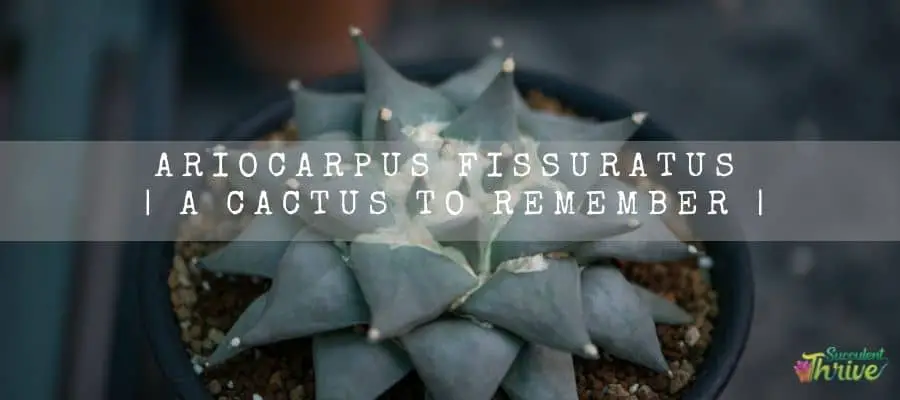
If I am to briefly explain how the name called “Ariocarpus ‘ formed, it is originating from the Greek language. It literally resembles the shape and the texture of the plants.
In fact, the plant’s shape and the texture resemble a look of the cap of an acorn. These plants are commonly known as Chautle Living Rock, False Peyote, Living Rock Cactus, Living Rock, Star Rock. They are native plants in Mexico.
Ariocarpus fissuratus have inherited their unusual appearances due to the squat and flat shape of the plants.
That said, the main highlight of these plants is their flower blossoms. Ariocarpus fissuratus are rare plants as their natural habitat is a limited area in the wild. Not only that but also, they would take a longer time to become matured too.
These are rarely spotted plants. In factCollectors gather these plants in massive numbers illegally and it has also caused the rare status of these plants.
Nevertheless, Ariocarpus fissuratus would make a great addition for your indoor garden collection.
So, before you start growing them, ensure that you are well aware of how to grow them. That said, you are at the right page to learn on how to grow these plants from scratch.
How do I identify Ariocarpus fissuratus?
Ariocarpus fissuratus came up with an unusual appearance as aforesaid. Literally they inherit a squat flat shape in their foliage.
Furthermore, you could spot the Ariocarpus fissuratus stems in green. They would be fleshy and usually form in a concentric pattern.
You call these stems as tubercles as well. Ariocarpus fissuratus are not spiky. Additionally, the top part of the Ariocarpus fissuratus would be covered in white or cream-colored wool. The flowers would arise from that part.
Ariocarpus fissuratus flower blossoming would take place in October and November. Usually, those inflorescences would be pink or magenta colored.
Those flowers would be 5 cm in size. Having said that, Ariocarpus fissuratus flowers would stay alive for a few days only. Once those flowers fade, they will come up with a fruit item in white or green.
Ariocarpus fissuratus are rosette forming plants. Those rosettes would resemble a star shape. Ariocarpus fissuratus would form as individual plants in general.
They would be just 20cm ( 6 inches ) in diameter when they fully mature. Ariocarpus fissuratus areolas would be 3mm in width.
Growth rate
Ariocarpus fissuratus grows at a slow pace. To further elaborate on this, they would take about five decades to grow to their fullest potential.
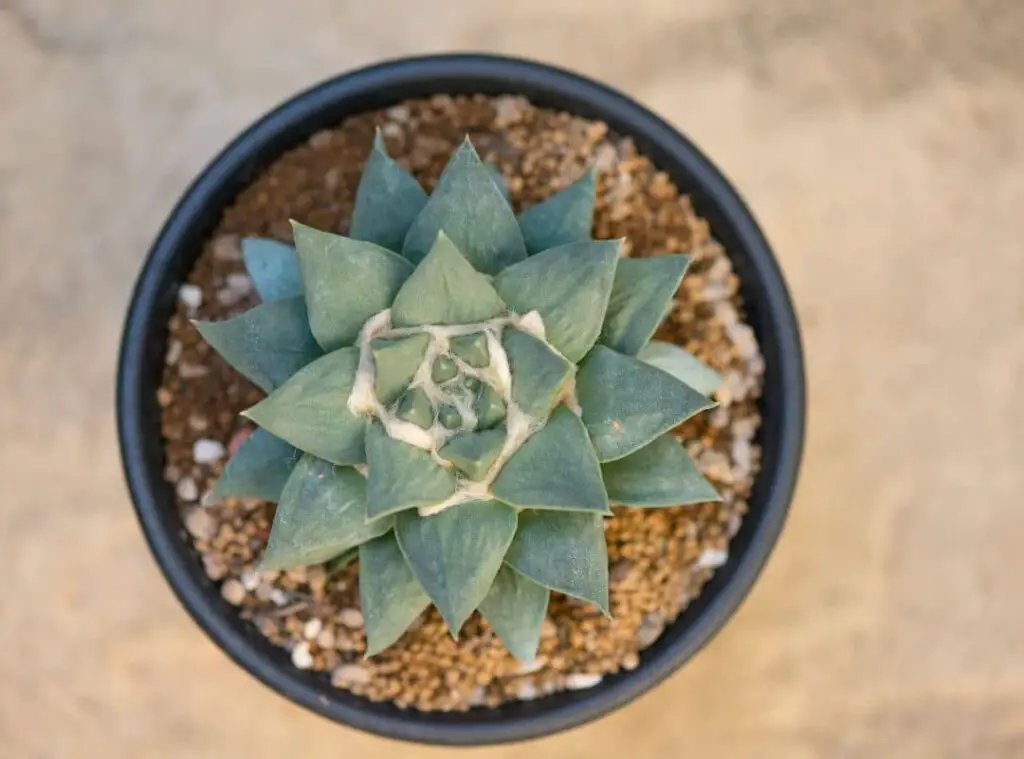
One look care guide
| Botanical Name | Ariocarpus fissuratus |
| Common Name | Chautle Living Rock, False Peyote, Living Rock Cactus etc. |
| Plant Type | Cactus |
| Mature Size | 20 cm in width |
| Sun Exposure | Full sunlight |
| Soil Type | Well draining . well aerated |
| Soil pH | Neutral |
| Bloom Time | October / November |
| Flower Color | pink or magenta colored |
| Hardiness Zones | USDA zones 10 and higher |
| Native Area | Mexico |
| Toxicity | Toxic |
| Average price | 12 USD |
How do you take care of Ariocarpus fissuratus?
Light Requirement
Ariocarpus fissuratus plants are renowned for their versatility as well as for their hardiness.
That being said, Ariocarpus fissuratus needs to have full sunlight exposure to keep their firm growth and for the flower blooming process as well.
To be precise, it is vital that they have at least eight hours of sunlight to grow firmly. One might find it difficult to cater when they grow them indoors. So, ideally what you could do is place them by a bright sunny windowsill.
However, if you still find it challenging to fulfill the sunlight requirement, you need to grow them under grow lights.
If you grow them in a container and have kept them indoors, you can bring them outdoors during summer so that they can gain ample sunlight.
However, you need to still slowly expose the plants to full sunlight, Unless if you expose them abruptly to full sunlight, it would result in the burns of the plants
Temperature and humidity
The optimal temperature which would suit the Ariocarpus fissuratus plants would be the room temperature.
That said the most appropriate temperature which would fit in for them would be around 80 degrees Fahrenheit – 90 degrees Fahrenheit ( 27 degrees Celsius – 32 degrees Celsius ).
Just like the light exposure, it is important that they get appropriate temperature levels so that they can grow to their best potential and produce flowers. unless the growth will be slower.
On the other hand, keep in mind that they don’t have frost tolerance. Do not expose the plants for temperatures below 50 degrees Fahrenheit ( 10 degrees Celsius).
If you accidently expose them to such unhealthy conditions, chances are that it would badly affect them. Hence if you have cultivated the plants outdoors, I suggest best would be to bring them indoors when conditions get much colder.
When it comes to the humidity aspect of the plants, I recommend the best would be to expose the plants to low humidity levels.
Ideally a humidity level of 30 % to 40 % would work well with these plants. Ariocarpus fissuratus plants can resist the hot and arid conditions as they have water conserved in their bodies.
Is it cold hardy?
Ariocarpus fissuratus plants are not frost hardy plants.
Growth Zone
The weather conditions in USDA zones 10 and above would fit in for these plants.
Watering Requirement
Ariocarpus fissuratus plants don’t tolerate excess watering at any time. If you do so, it would easily pave the way for the development of root rot.
The over exposure for excess water for prolonged periods would turn out to be lethal on the plants.
If I guide you on how to water the Ariocarpus fissuratus plants during their active growing phase, you should water them once every 7-10 days. That said, you should allow the soil to dry between two watering sessions also.
Consider that you have cultivated them in shallow containers , then I recommend using the bottom watering method.
You simply have to soak the planter with water for a few minutes. Next , let the excess water move out from the pots and place it back on the tray.
Bear in mind that Ariocarpus fissuratus plants can survive with minimal water during winter. So, you should reduce watering the plants to once every six weeks during such times.
Furthermore, I suggest you suspend watering the plants from late autumn to early spring entirely.
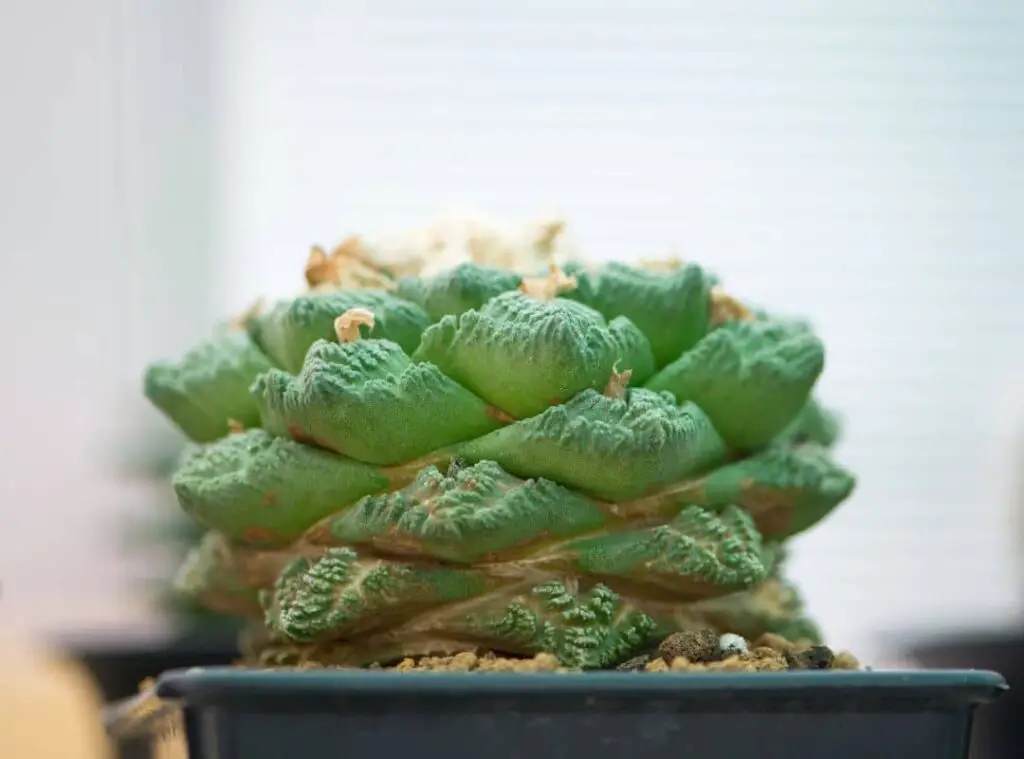
Soil Requirement Type / pH
Ariocarpus fissuratus plants also need to have the right soil mix to grow firmly. That literally means it has to be a porous and well aerating soil mix.
In addition to that, it should be fast draining too. Further I suggest you use a soil mix which is not too rich in humus too.
Most importantly, it needs to have a neutral ph. as well. Do not proceed with universal soil mix as they don’t fulfill the aforesaid requirements.
However, if you still wish to have them, you need to amend them by applying soil amendments so that it would better drain.
If you wish, you may make use of cactus soil mix or bonsai mix and mix them with some pumice and grow the plants there.
When you do that, you need to add topsoil, calcined clay, coconut fiber , perlite, or pumice equally.
Pot size Potting and Repotting
Choosing the right pot is important just like fulfilling the aforesaid growth requirements.
Ariocarpus fissuratus plants consist of thick tuberous roots where the roots could grow massively compared to the size of the plants.
As such, a wider container which has at least one or two draining holes would perfectly fit in for them. Material wise, ceramic, terracotta made pots would be ideal. That will avoid the soil getting soggy and damp.
When it comes to repotting, you could do it less often as they are a slow growing set of plants in general. On the other hand, you do not need to repot the plants quite often either.
If you wish to ascertain whether you need to repot the plants, you may check the underside of the container and see whether the roots have formed out of the pot.
If you spot the roots have outgrown , you need to repot them at that time itself. That said, you need to do it with caution and handle the roots carefully.
If you don’t do that, chances are that the roots may be damaged. Eventually it may even result in the death of the plants.
Where to Plant
Ariocarpus fissuratus plants will thrive irrespective of the place you grow them as log as they get warmer temperatures and adequate sunlight levels.
Fertilizer and time of year
A light feeding would be ideal on these plants during spring and summer. You may feed them once a month during their active growing seasons.
Skip feeding them in winter completely unless it would make the plants go through stress. Furthermore, it would also lead for pathogen growth too.
Go for a fertilizer which has a low percentage in Nitrogen and a high percentage in potassium and phosphorus. Besides, keep in mind that you need to dilute it to quarter strength and then apply on the plants.
Flower
Ariocarpus fissuratus plants blossom with flowers in October and November. They would form in pink or in magenta colors.
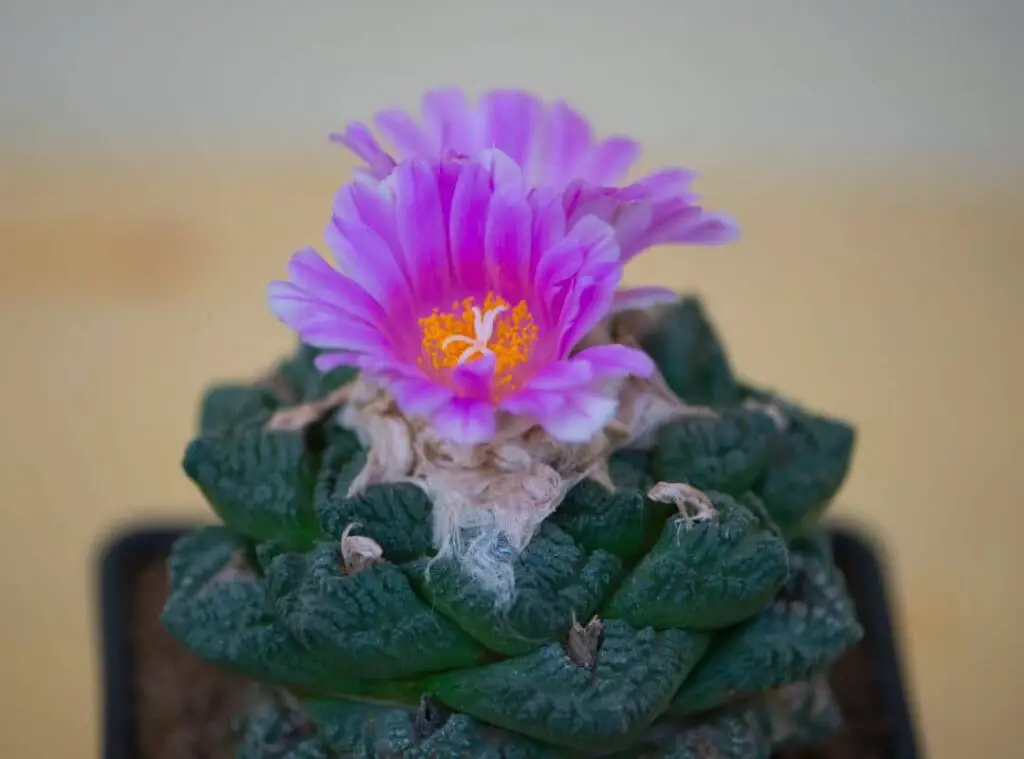
Dormancy
Ariocarpus plants usually go into semi-dormancy during the middle of summer.
Toxicity
As per records, Ariocarpus fissuratus are supposed to be poisonous plants. They consist of a chemical substance which is known as hordenine.
This element can speed up the pulse rate and blood pressure once you ingest them. So, best is to keep them far from both kids and from animals as well.
Common bugs and illnesses
Ariocarpus fissuratus can resist pests’ attacks and other regular diseases in general. Having said that, if you supplied them with excess watering it would pave the way for deadly conditions such as root rots.
That is simply because the pants are quite responsive towards over watering. So, to avoid that happening, you need to always water the plants if their soil is dry and allow the soil to wither between two watering sessions.
Not only that but also, ensure that you do not let the stem or the wool get wet too. Unless it would cause crown rot in the plants.
Apart from that, Ariocarpus fissuratus may go through mealybug attacks occasionally too. They would usually tend to occupy the thick stems.
If you spot any mealybug, you need to remedy them by using a cotton swab which is soaked in an insecticidal soap solution. You may apply this once every week.
Ariocarpus fissuratus benefits
Ariocarpus fissuratus are beneficial for medicinal purposes. For example, ancestors have used them to remedy the wounds, snakes’ bites and bruises as well.
Last but not least they would make great additions for both indoor landscaping and for outdoor landscaping as well.
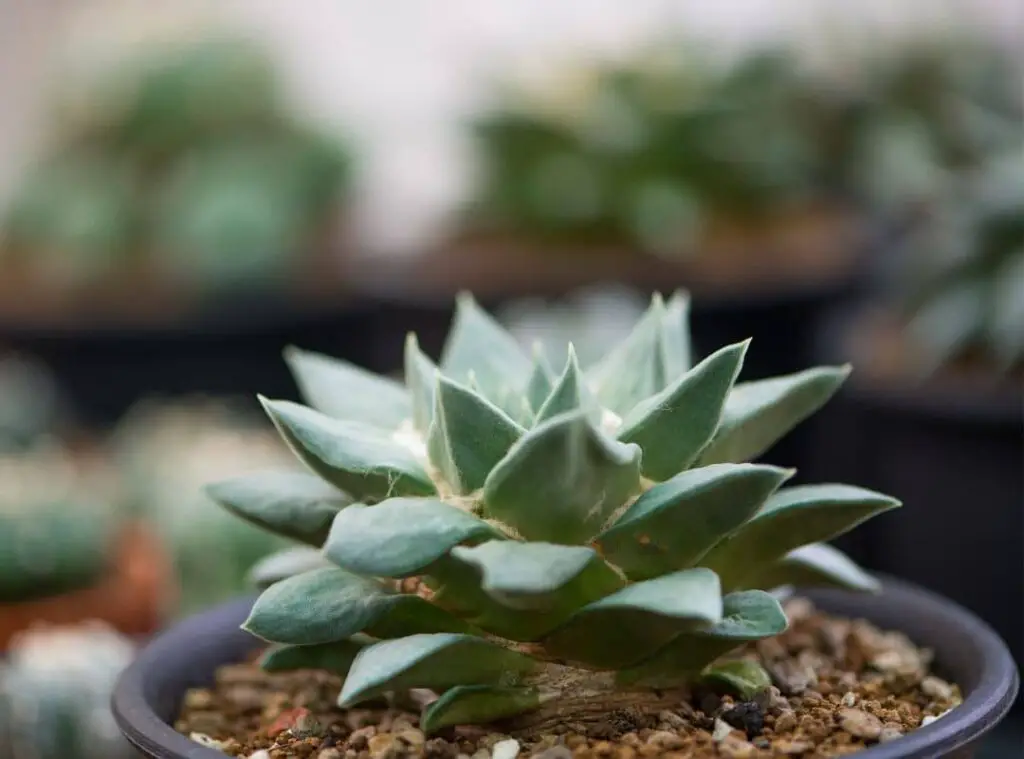
How to propagate Ariocarpus fissuratus
You may propagate these plants by using two methods mainly. They are using their seeds and the stem cuttings.
However, since these are slow growing plants, you need little patience to see the results of the propagation process. it could be one or two months to several months even.
Stem cutting propagation method on Ariocarpus fissuratus plants
I recommend applying the stem cutting method on the older plants which will consist of plenty of tubercles.
You need to first snip off one or two tubercles by using sharp sterilized blades towards bottom part of the cactus.
Next keep the cuttings in a dry well aerated place for about one week’s time. After that you could see how those cuttings had developed callus at the bottom.
In the meantime, prepare a soil mix which is filled with coarse sand. Next apply some rooting hormone powder to the cuttings edges and lay them on the tray.
Ensure the edges of the cuttings are lightly covered by the sand. Next, water them lightly and place the specimen in a warmer room but not exposed for direct sunlight.
Whenever you spot, they have developed new growths, you may shift them to fresh pots and grow them as individual plants.
Seeds cutting propagation method on Ariocarpus fissuratus plants
I would say if you were looking for a less troublesome propagation method you may go ahead with the seed’s propagation method.
You may first obtain the seeds from the fruits from the Ariocarpus fissuratus plants. Next, you need to arrange a shallow tray and fill it with a fresh well draining soil mix.
After that moisten it using a spray bottle. Finally, you can place the seeds on the soil mix whilst ensuring that they are one inch apart.
Additionally, I suggest you add a horticultural sand layer and moisten it from a spray bottle. As the next step you should cover the specimen with a transparent plastic bag.
Finally, you can keep the specimen in a place where they will be protected from direct sunlight but in warmer temperatures.
A temperature range of 72 degrees Fahrenheit ( 22 degrees Celsius) would be optimal for these plants. The germination would take place within three months’ time.
Once you spot the seedlings forming and they are about half an inch in height, you could transplant them in fresh pots.
Conclusion
Ariocarpus fissuratus are unusual plants as explained right in the beginning of the article. So, if you manage to look after these plants dearly, they will survive for a number of decades and grace your entire space with spectacular flowers as well.
If I briefly recap on what we covered here, Ariocarpus fissuratus are endemic plants to Mexico which could be about 20 cm in width at maturity.
They are easy to care plants and all you need to provide are warmer temperatures, sufficient sunlight and a well-draining and a well aerated soil mix.
You could make new plants from using either the seeds propagation method or the stem cutting propagation method. So, happy cultivating with Ariocarpus fissuratus!
Read Next : Planting Succulents In Deep Pots (Think Different)


